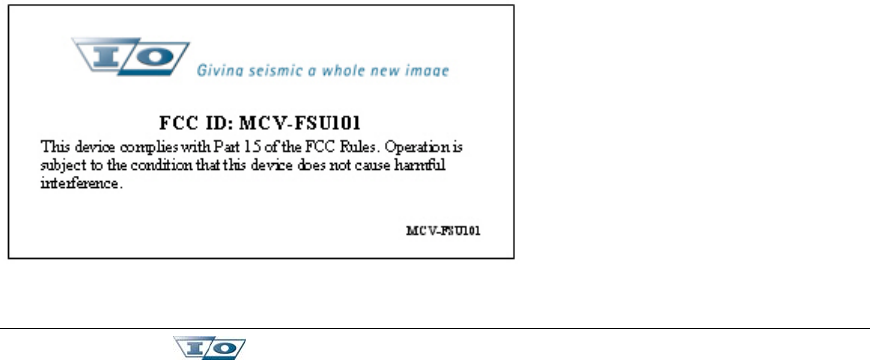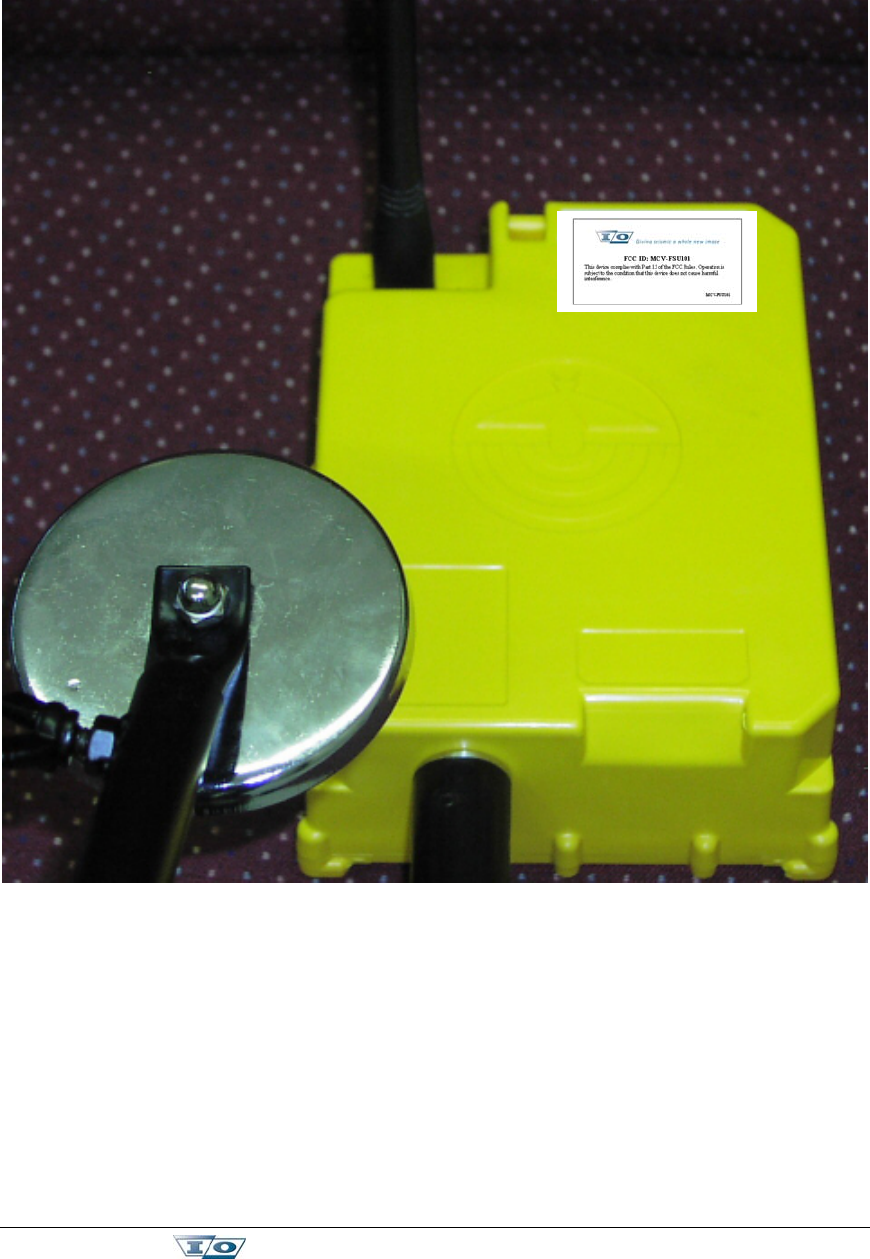INOVA Geophysical Equipment FSU101 Field Station Unit User Manual I O FireFly User s Guide
INOVA Geophysical Equipment Limited Field Station Unit I O FireFly User s Guide
User Manual

FireFly
Field Station Unit (FSU)
User Guide

Input/Output, Inc. 2
FSU User Guide
Table of Contents
Overview: Field Station Unit (FSU)................................................................................... 3
About Field Station Unit (FSU)..................................................................................... 3
Regulatory and Safety Guidelines .................................................................................. 3
Type Approval ...............................................................Error! Bookmark not defined.
Licensing......................................................................................................................... 5
FCC ID Label.................................................................................................................. 5
Deploying and Operating the FSU...................................................................................... 7
Before you begin............................................................................................................. 7
Bringing up the FSU....................................................................................................... 7
Shutting down the FSU................................................................................................... 7

Input/Output, Inc. 3
FSU User Guide
Overview: Field Station Unit (FSU)
About Field Station Unit (FSU)
The FSU is a battery-powered device with RF radio, GPS, Bluetooth, Ethernet and solid-
state memory designed to record seismic data. A central station computer (CSC) controls
FSU operations. The FSU records data sent from a seismic sensor and then downloads
the data to a data transcription system.
The FSU is deployed in the field and is intended for use by properly trained seismic field
personnel.
Regulatory and Safety Guidelines
Regulations regarding the use of the radio modems vary greatly from country to country.
In some countries, the unit can be used without obtaining an end-user license. Other
countries, such as United States, require end-user licensing. Consult your local
communications governing agency for licensing information. Before operating an FSU
with a radio modem, determine if authorization or a license to operate the unit is required
in your country. Obtaining an operator’s permit or license for the FSU for the
location or country-of-use is the responsibility of the end user.
NOTE:
This device complies with Part 15 of the FCC Rules. Operation is subject to the condition
that this device does not cause harmful interference.
NOTE:
This device complies with Part 15 of the FCC Rules. Operation is subject to the following
two conditions: (1) this device may not cause harmful interference, and (2) this device
must accept any interference received, including interference that may cause undesired
operation.
NOTE:
This equipment has been tested and found to comply with the limits for a Class A digital
device, pursuant to Part 15 of the FCC Rules. These limits are designed to provide
reasonable protection against harmful interference when the equipment is operated in a
commercial environment. This equipment generates, uses, and can radiate radio
frequency energy and, if not installed and used in accordance with the instruction manual,
may cause harmful interference to radio communications. Operation of this equipment in
a residential area is likely to cause harmful interference in which case the user will be
required to correct the interference at his own expense.

Input/Output, Inc. 4
FSU User Guide
NOTE:
In order for the equipment to work, the antenna must be professionally installed. In
United States, for the 217 – 220 MHz band, the maximum antenna height above average
terrain (HAAT) is 152 meters (500 feet). Improper installation could void the user’s
authority to operate the equipment.
Certification
Certification, covers technical parameters of the equipment related to emissions that can
cause interference. Certification is granted to the manufacturer or importer of the
transmission equipment, independent from the operation or licensing of the units. Some
countries have unique technical requirements for operation in certain radio modem
frequency bands. Unauthorized modification to the units voids the Certification, the
warranty and the operational license of the equipment.
CAUTION:
Changes or modifications to this equipment not expressly approved, in writing, by
Input/Output could void the user’s authority to operate the equipment.

Licensing
Many countries require that the operator of a radio, or radio modem, obtain a license
prior to operating the radio, or radio modem. Some do not. Consult your local
communications governing agency for licensing information. Obtaining an operator’s
permit or license for the Firefly FSU for the location or country-of-use is the
responsibility of the end user.
Before operating this radio modem, you are legally required to obtain frequency licenses
as required by the country-of-use. Please contact your local communications governing
agency for the licensing requirements for each of these radio modems.
Safety
Exposure to radio frequency (RF) energy is an important safety consideration. The FCC
has adopted a safety standard for human exposure to radio frequency electromagnetic
energy emitted by FCC regulated equipment as a result of its actions in General Docket
79- 144 on March 13, 1986. Proper use of this radio modem results in exposure below
government limits. The following precautions are recommended:
• A 20 cm separation should be maintained between the antenna and all persons during
normal operation, per Part 1.1307 of the FCC Rules and Regulations.
• All equipment must be properly grounded according to Input/Output installation
instructions for safe operation.
• All equipment should be serviced only by a qualified technician.
FCC ID Label
Figure 1 is an example of the FCC ID label for the FSU radio. Figure 2 shows where the
label is located on the FSU radio. The size of the label is approximately 1.75 X 3.50
inches.
FCC ID: MCV-FSU101
Figure 1. FCC ID Label: FSU Radio
Input/Output, Inc. 5
FSU User Guide

Figure 2. FCC ID Label Location: FSU Radio
Input/Output, Inc. 6
FSU User Guide

Input/Output, Inc. 7
FSU User Guide
Deploying and Operating the FSU
Before you begin
Deploy the FSU by placing it on the ground.
Bringing up the FSU
1. Turn on the CSC and C/RU hardware.
2. Execute the Firefly software on CSC.
3. Turn on the FSU by swiping a magnet over it.
4. Turn on the NavTool and execute the NavTool software.
5. From the NavTool software, initiate deployment of the FSU by entering the necessary
parameters.
6. In the FireFly software, open the Deployment domain view. The FSU should be on
the list. Make sure Deployment domain is in Manual mode.
7. Right-click on the FSU and select Deploy. The status should change to Deployed.
8. Right-click on the FSU and select Status Pull.
9. Right-click on the FSU and select Sleep.
Shutting down the FSU
1. In the Firefly software, open the FSU domain view.
2. Select the FSU from the list, right-click on FSU, and select Wakeup.
3. Wait for Wakeup to finish.
4. Select the unit from FSU domain again, right-click, and select Undeploy. The FSU
should disappear from the FSU domain view.
5. Shut down CSC operating system.
6. Turn off CSC and C/RU hardware.